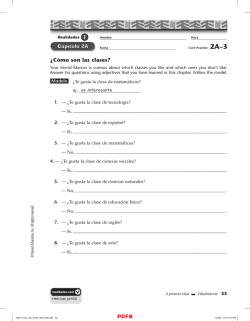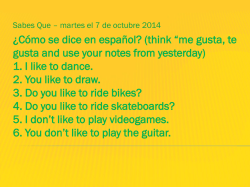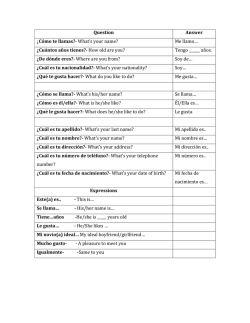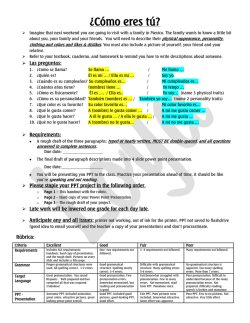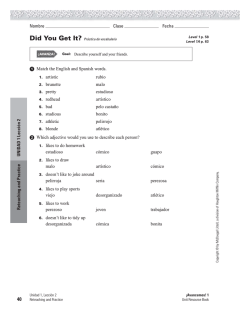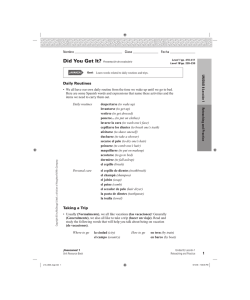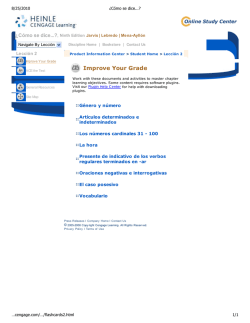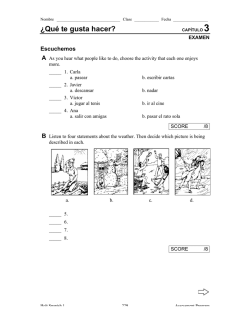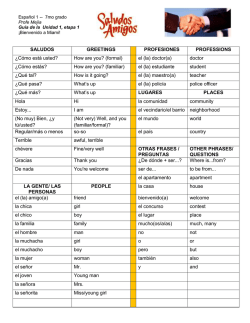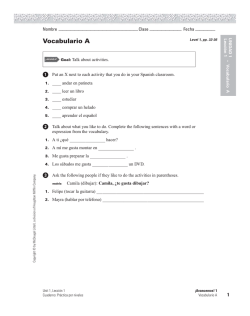
Subject Pronouns and ser - Asbury Park School District
TRANSPARENCY 16 Gramática, Unidad 1, Lección 1 Subject Pronouns and ser Ser means to be. Use ser to identify a person or say where he or she is from. How do you use this verb with subject pronouns? Here’s how: Singular Plural yo soy tú eres you are usted es él, ella es I am you are he, she is Copyright © by McDougal Littell, a division of Houghton Mifflin Company. Yo soy de Buenos Aires. I am from Buenos Aires. Singular Use tú with • a friend • a family member • someone younger nosotros(as) somos we are vosotros(as) sois you are ustedes ellos(as) son son you are they are Ellas son de Venezuela. They are from Venezuela. Plural • Use vosotros(as) with friends, family, and younger people only in Spain. • Use ustedes with people you don’t know, older people, and Use usted with people for whom you want to • a person you don’t know show respect in Spain; use it in • someone older Latin America with any group of someone for whom you • people. want to show respect • Use nosotras, vosotras, and ellas when all the people you are talking about are female. ¡Avancemos! 1 Unidad 1, Lección 1 16 TRANSPARENCY 17 Gramática, Unidad 1, Lección 1 Gustar with an Infinitive Use gustar to talk about what people like to do. Here’s how: Use phrases like me gusta + infinitive. Me gusta dibujar. Te gusta dibujar. I like to draw. Le gusta dibujar. You (formal singular) like to draw. He/She likes to draw. Nos gusta dibujar. We like to draw. Os gusta dibujar. You (familiar plural) like to draw. Les gusta dibujar. You (plural) like to draw. They like to draw. You (familiar singular) like to draw. Copyright © by McDougal Littell, a division of Houghton Mifflin Company. When you want to really emphasize or identify the person that you are talking about, add a + noun/pronoun. A Sonia le gusta leer. A ella le gusta leer. Sonia likes to read. She likes to read. These are the pronouns that follow a. A mí me gusta dibujar. A ti te gusta dibujar. A usted le gusta dibujar. A él, ella le gusta dibujar. ¡Avancemos! 1 A nosotros(as) nos gusta dibujar. A vosotros(as) os gusta dibujar. A ustedes les gusta dibujar. A ellos(as) les gusta dibujar. Unidad 1, Lección 1 17 TRANSPARENCY 18 Gramática, Unidad 1, Lección 2 Definite and Indefinite Articles In Spanish, articles match nouns in gender and number. Here’s how: All Spanish nouns, even if they refer to objects, are either masculine or feminine. • Nouns ending in -o are usually masculine. • Nouns ending in -a are usually feminine. Noun Indefinite Article Noun el chico un chico the boy a boy los chicos unos chicos the boys some boys la chica una chica the girl a girl las chicas unas chicas the girls some girls Copyright © by McDougal Littell, a division of Houghton Mifflin Company. Feminine Masculine Definite Article Singular Plural Singular Plural matches matches Los libros son para la maestra. The books are for the teacher. To form the plural of a noun, add -s if the noun ends in a vowel. Add -es if the noun ends in a consonant. vowel estudiante ¡Avancemos! 1 estudiantes consonant mujer mujeres Unidad 1, Lección 2 18 TRANSPARENCY 19 Gramática, Unidad 1, Lección 2 Noun-Adjective Agreement In Spanish, adjectives match the gender and number of the nouns they describe. Copyright © by McDougal Littell, a division of Houghton Mifflin Company. Feminine Masculine Here’s how: Singular Plural el chico alto los chicos altos the tall boy the tall boys la chica alta las chicas altas the tall girl the tall girls • Adjectives that end in -e match both genders. • Many adjectives that end in a consonant match both genders. • Some adjectives that end in a consonant add -a to form the feminine singular. These exceptions have to be memorized. • To make an adjective plural, add -s if it ends in a vowel; add -es if it ends in a consonant. ¡Avancemos! 1 el maestro inteligente la maestra inteligente el amigo joven la amiga joven el chico trabajador la chica trabajadora las chicas trabajadoras los chicos trabajadores Unidad 1, Lección 2 19
© Copyright 2025
